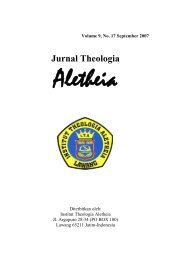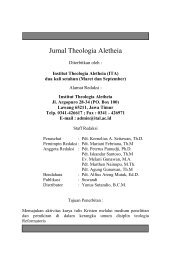download - Sekolah Tinggi Theologia Aletheia Lawang
download - Sekolah Tinggi Theologia Aletheia Lawang
download - Sekolah Tinggi Theologia Aletheia Lawang
You also want an ePaper? Increase the reach of your titles
YUMPU automatically turns print PDFs into web optimized ePapers that Google loves.
94<br />
Even if we regard the hypothesis that the yelammendenu<br />
rabbenu method forms the template for composition as being too<br />
fanciful, the point that the frame coheres well with the parable still<br />
stands. The parable is framed by questions on the identity of the<br />
neighbour (vv. 29, 36). The objection that there is a discrepancy<br />
between the lawyer‘s second question (i.e., who is my neighbour?)<br />
and Jesus‘ answer in query form (i.e., who has been a neighbour?)<br />
misses the profound subtlety of the message, which we hope to<br />
demonstrate later.<br />
Fourthly, there is a very high degree of historical plausibility to<br />
the frame. 126 The frame has the command to love the neighbour as its<br />
focus and we do know that the love command is one key aspect of<br />
the teaching of Jesus of Nazareth, whether this is to be directed to<br />
one’s enemies or otherwise. 127 Moreover, the question asked by the<br />
lawyer coheres well with the first century Jewish context. It is about<br />
‘inheriting eternal life’ and this means not our modern popular<br />
understanding of going to heaven when one dies but the thoroughly<br />
Jewish concept of the inheritance of the age to come. The life of the<br />
age to come is the vindicated and resurrected life which will be lived<br />
before Yahweh and last forever (cf. Dan 12.1-3; Ps. Sol. 3.11-12; BJ<br />
3.374; Apion 2.218;). 128 Furthermore, the lawyer’s seeking to be<br />
justified () need not be construed as an attempt to<br />
Authority and Transmission in Ancient Israel, Ancient Judaism and the<br />
Matthean Community, Stockholm: Almqvist & Wiksell, 1994.<br />
126 This is now known as the criterion of historical plausibility and some<br />
prominent scholars who defend some version of it are J. Jeremias, The Theology<br />
of the New Testament I: The Proclamation of Jesus, London: SCM, 1971; G.<br />
Theissen and D. Winter, The Quest for the Plausible Jesus: The Question of<br />
Criteria, Lousiville: Westminster John Knox, 2002; and Wright, Jesus and the<br />
Victory of God, Minneapolis: Fortress, 1996.<br />
127 On the love command, see J. Piper, Love Your Enemies, Cambridge:<br />
Cambridge University Press, 1979. Cf. R. Neudecker, ‗―And You Shall Love<br />
Your Neighbour as Yourself — I am the Lord‖ (Lev 19,18) in Jewish<br />
Interpretation‘, Bib 73 (1992), pp. 512-14.<br />
128 Cf. E. Schürer, The History of the Jewish People in the Age of Jesus Christ<br />
(175 B.C.-A.D. 135), Vol. 2, Edinburgh: T. & T. Clark, 1979, p. 495.




